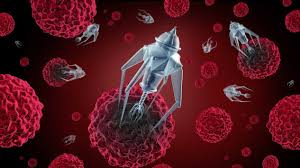
Imagine a future where tiny machines swim through your bloodstream, identifying problems, delivering medicine, or repairing tissues at the cellular level. Nanobots—microscopic robots measured in billionths of a meter—promise to transform medicine by working inside the human body in ways previously only dreamed of in science fiction.
1. What Are Nanobots?
Nanobots are ultra-small robots designed to interact with biological systems at the molecular and cellular scale. Their functions may include:
- Targeted drug delivery: Releasing medication directly to diseased cells.
- Repairing tissues: Fixing damaged cells or even assisting in organ regeneration.
- Monitoring health: Detecting early signs of disease or tracking biomarkers in real time.
- Clearing blockages: Removing arterial plaques or harmful substances from the bloodstream.
These microscopic machines could revolutionize how we diagnose, treat, and prevent diseases.
2. Potential Medical Applications
- Cancer treatment: Nanobots can deliver chemotherapy directly to tumors, minimizing side effects.
- Cardiovascular health: Removing clots or repairing arterial damage without invasive surgery.
- Neurological repair: Targeting neurons to help treat conditions like Parkinson’s or Alzheimer’s.
- Immune system support: Assisting white blood cells in fighting infections or autoimmune diseases.
The promise is precise, minimally invasive treatment tailored to each patient’s needs.
3. How Nanobots Could Work
- Navigation: Using magnetic fields, chemical gradients, or acoustic signals to reach target areas.
- Sensing: Equipped with nanosensors to detect specific cells, chemicals, or environmental conditions.
- Action: Release drugs, repair molecules, or remove harmful agents as programmed.
- Communication: Report findings back to doctors via external monitoring systems.
By combining robotics, nanotechnology, and AI, nanobots could operate autonomously or under real-time guidance.
4. Challenges and Considerations
- Safety concerns: Ensuring nanobots do not trigger immune reactions or cause unintended damage.
- Control and programming: Designing reliable, accurate navigation in the complex human body.
- Ethical questions: Use of internal robots raises privacy and consent issues.
- Regulatory hurdles: Approval from health authorities requires extensive testing and clinical trials.
5. The Future of Nanobot Medicine
Researchers are actively developing prototypes for targeted drug delivery, tissue repair, and disease monitoring. As technology progresses, nanobots may become routine medical tools, providing treatments that are faster, safer, and far more precise than current methods.
Final Thoughts
Nanobots represent a radical leap in medical technology, turning the human body into a space where microscopic machines can diagnose, repair, and protect from within. While many challenges remain, their potential to revolutionize healthcare is immense.